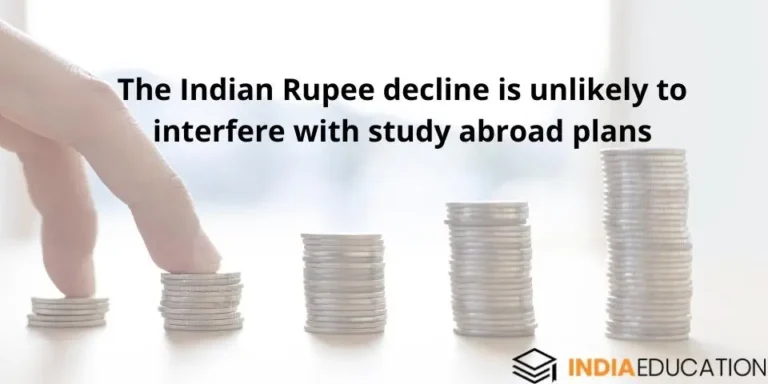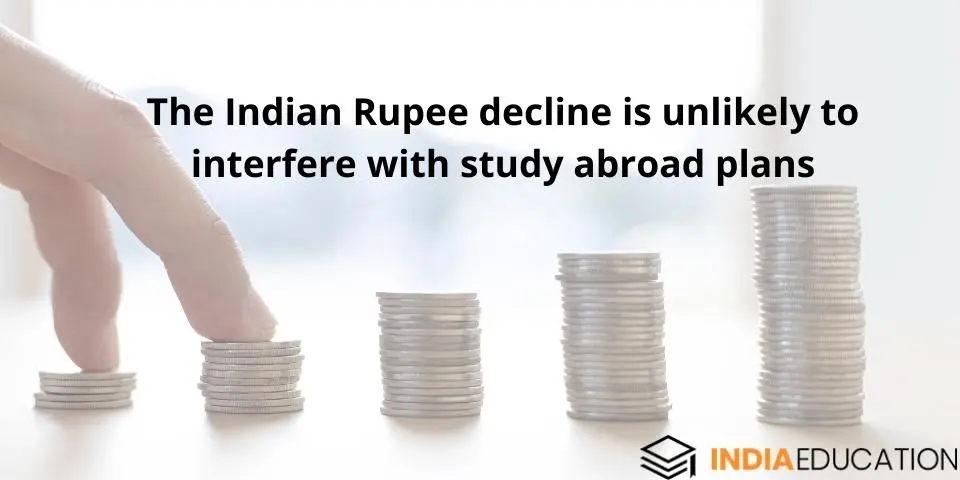- Home»
- Author»
- Amit Yadav»
The Indian Rupee decline is unlikely to interfere with study abroad plans
Amit Yadav

Indian students studying abroad and those getting ready to travel abroad will undoubtedly experience financial hardship as a result of the dropping rupee, but experts say this is unlikely to deter hopefuls from going through with their plans because the return on investment is still compelling.
On Tuesday, the rupee breached the 80-point threshold for the first time, dropping to its lowest level versus the US dollar. Since the start of 2022, the value of the Indian rupee relative to the US dollar has fallen by nearly 7%.
“Students are pouring into reputable universities despite the rupee’s decline.” Students and their parents typically arrange for their overseas education over the course of two to three years. People will invest despite the rupee’s decline because of the quality of education and the return on investment, according to Collegify co-founder Rohan Ganeriwala.
Leading overseas education consultants, including ReachIvy, Leverage Edu, Collegify, and Yocket, have seen the number of students going to study abroad more than double since the start of travel after the relaxing of Covid-19, driven by pent-up demand. This is despite the escalating cost of US education. The demand for international education has also been fueled by the expansion of educational loan alternatives, the availability of scholarships, grants, and other forms of financial aid, and the rise of Indians from smaller towns who want to study abroad.
Private banks, state-owned banks, and non-bank financial institutions all offer a variety of financing choices.
With 60% of students traveling abroad choosing the US, it is the most popular country for Indians looking to study abroad. Numerous Indian students also choose to study abroad in the UK, Germany, Canada, and Singapore.
For a lakh or two lakhs, according to Akshay Chaturvedi, founder of Leverage Edu, “no one will opt out of the US.” He claimed, “This won’t be a hindrance to someone making a life decision to pursue higher education.” Additionally, more students are considering possibilities outside of the US for their education. A rising number of Indian students are choosing to study in nations like the UK, Australia, and other European nations like France and Germany.
However, that isn’t because of the rupee’s decline (against the US dollar) but rather a number of other variables, including lax work visa requirements and more affordable study alternatives, “Chaturvedi added. It can’t be a hasty decision. People have budgeted between Rs 40 and 50 lakh for higher education abroad, and they do so over time, according to Sumeet Jain, co-founder of Yocket, which has seen a fivefold growth in the number of students who travel to study.
The return on investment will likewise increase even though the initial investment has gone up. There has been a 1.5–2 percentage point rise in loan inquiries, according to education loan providers like Avanse Financial Services. Millions of Indian students aspire to study overseas. According to Amit Yadav, chief strategy officer, digital business, Avanse, “The demand for international education is mostly driven by the aspiration to obtain a quality higher education and a better standard of life, and we don’t envisage any change in this due to the currency depreciation.”
When developing education finance solutions, organizations with a focus on education typically take into account currency changes and other factors that have an impact on the overall cost, according to Yadav. According to him, an Indian student will be somewhat less affected by devaluation than academic aspirants from other nations because the proportional depreciation of the rupee over the past year has been less than in certain industrialized economies.
On the other hand, experts speculated that the depreciation of the rupee may work in favor of students who are currently enrolled in US universities and who will be repaying their student loans once they have finished their degrees and found a job overseas that pays in US dollars, making those repayments more affordable. According to Amitabh Jhingan, leader of the education sector at EY Parthenon, “over the years, a declining rupee has not had an influence on the overall number of students traveling abroad.” “Having said that, there will undoubtedly be some influence on affordability in the short term, which may lead to some choosing lower cost places or accepting a larger amount of financing,” the author adds.
Latest News

CBSE Compartment Result 2023 OUT: Click For Direct Link



CSAB 2023: Special Round Registration Begins Today


People Reading Now

CBSE Compartment Result 2023 OUT: Click For Direct Link



CSAB 2023: Special Round Registration Begins Today







